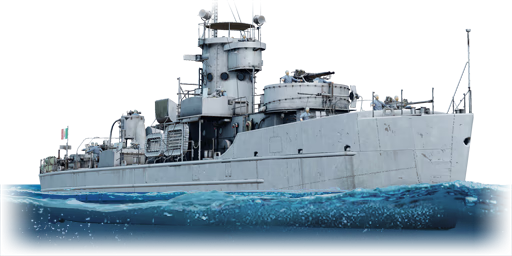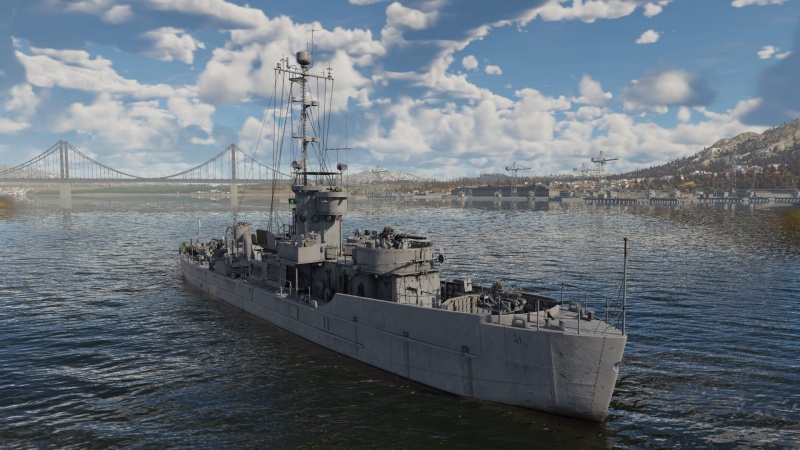Difference between revisions of "Alano"
(→Description) (Tag: Visual edit) |
Jareel_Skaj (talk | contribs) (Added side profile) |
||
| Line 7: | Line 7: | ||
{{Specs-Card | {{Specs-Card | ||
|code=it_alano_9851 | |code=it_alano_9851 | ||
| − | |images={{Specs-Card-Image|GarageImage_{{PAGENAME}}.jpg}} | + | |images={{Specs-Card-Image|GarageImage_{{PAGENAME}}.jpg|GarageImage {{PAGENAME}} (2).jpg}} |
}} | }} | ||
Revision as of 18:24, 27 June 2024
| This page is about the Italian motor gun boat Alano. For other versions, see Landing Craft Support (Family). |
Contents
Description
The Alano-class, Alano (L9851) is a motor gun boat of the Landing Craftt Support (LCS) in particular the Large type Mk.3 (complete name LCS(L)(3)), laid down on August 1944 by Commercial Iron Works, Portland in USA, launched on 16 September 1944 and put in service on 30 September 1944 as LCS(L)34, was used in the Pacific war as a support ship for the allied landing with her sisters, in particular, the LCS(L)34 participated at the landing of Tarakan e Balikpapan, after the world war II was given to Italy on 25 July 1951 with the MDAP and was used as coast guard ship and renamed as Alano (L9851) and the LCS(L)(3) name was renamed as Alano Class, on August 1971 was decommissioned and radiated.
The Alano-class, Alano (L9851) was introduced in Update "Seek & Destroy", is a large gunboat with powerful armament composed of five 40mm Bofors (40 mm) Mk.1 (4) and Mk.3 (1), four 20 mm/70 Oerlikon Mk. II and at last four AN-M2 (12.7 mm) but with terrible survivability, as difference from the LCS(L)(3) the Aano doesn't have a 76mm, meanwhile the differences of Asagao (YTE-01), max speed and anti-submarine charges, this type of ships are the necessity to be used with a low presence of enemy destroyers and more modern enemy boats.
General info
Survivability and armour
Talk about the vehicle's armour. Note the most well-defended and most vulnerable zones, e.g. the ammo magazine. Evaluate the composition of components and assemblies responsible for movement and manoeuvrability. Evaluate the survivability of the primary and secondary armaments separately. Don't forget to mention the size of the crew, which plays an important role in fleet mechanics. Save tips on preserving survivability for the "Usage in battles" section. If necessary, use a graphical template to show the most well-protected or most vulnerable points in the armour.
Mobility
Write about the ship's mobility. Evaluate its power and manoeuvrability, rudder rerouting speed, stopping speed at full tilt, with its maximum forward and reverse speed.
| Mobility Characteristics | |||
|---|---|---|---|
| Game Mode | Upgrade Status | Maximum Speed (km/h) | |
| Forward | Reverse | ||
| AB | |||
| Upgraded | 39 | 25 | |
| RB/SB | |||
| Upgraded | 29 | 19 | |
Modifications and economy
Armament
Primary armament
Provide information about the characteristics of the primary armament. Evaluate their efficacy in battle based on their reload speed, ballistics and the capacity of their shells. Add a link to the main article about the weapon: {{main|Weapon name (calibre)}}. Broadly describe the ammunition available for the primary armament, and provide recommendations on how to use it and which ammunition to choose.
- Universal: AP-T · HEFI-T
- 40 mm HE clips: HEFI-T · HEFI-T · HEFI-T · AP-T
- 40 mm AP clips: AP-T · AP-T · AP-T · HEFI-T
| Penetration statistics | |||||||
|---|---|---|---|---|---|---|---|
| Ammunition | Penetration @ 0° Angle of Attack (mm) | ||||||
| 10 m | 100 m | 500 m | 1,000 m | 1,500 m | 2,000 m | ||
| HEFI-T | 3 | 3 | 3 | 3 | 3 | 3 | |
| AP-T | 81 | 78 | 68 | 58 | 49 | 41 | |
| Shell details | ||||||||||||
|---|---|---|---|---|---|---|---|---|---|---|---|---|
| Ammunition | Velocity (m/s) |
Projectile mass (kg) |
Fuse delay (m) |
Fuse sensitivity (mm) |
Explosive mass (TNT equivalent) (g) |
Ricochet | ||||||
| 0% | 50% | 100% | ||||||||||
| HEFI-T | 874 | 0.9 | 0 | 0.1 | 67.13 | 79° | 80° | 81° | ||||
| AP-T | 874 | 0.89 | - | - | - | 47° | 60° | 65° | ||||
Secondary armament
Some ships are fitted with weapons of various calibres. Secondary armaments are defined as weapons chosen with the control Select secondary weapon. Evaluate the secondary armaments and give advice on how to use them. Describe the ammunition available for the secondary armament. Provide recommendations on how to use them and which ammunition to choose. Remember that any anti-air armament, even heavy calibre weapons, belong in the next section. If there is no secondary armament, remove this section.
- Universal: HEF-T · HEF-I · AP-T
- 20 mm HE: HEF-T · HEF-I · AP-T · HEF-I
- 20 mm AP: AP-T · AP-T · AP-T · HEF-I
| Penetration statistics | |||||||
|---|---|---|---|---|---|---|---|
| Ammunition | Penetration @ 0° Angle of Attack (mm) | ||||||
| 10 m | 100 m | 500 m | 1,000 m | 1,500 m | 2,000 m | ||
| HEF-T | 2 | 2 | 2 | 2 | 2 | 2 | |
| HEF-I | 2 | 2 | 2 | 2 | 2 | 2 | |
| AP-T | 34 | 32 | 24 | 17 | 12 | 8 | |
| Shell details | ||||||||||||
|---|---|---|---|---|---|---|---|---|---|---|---|---|
| Ammunition | Velocity (m/s) |
Projectile mass (kg) |
Fuse delay (m) |
Fuse sensitivity (mm) |
Explosive mass (TNT equivalent) (g) |
Ricochet | ||||||
| 0% | 50% | 100% | ||||||||||
| HEF-T | 830 | 0.12 | 0 | 0.1 | 6.57 | 79° | 80° | 81° | ||||
| HEF-I | 830 | 0.12 | 0 | 0.1 | 11.17 | 79° | 80° | 81° | ||||
| AP-T | 830 | 0.12 | - | - | - | 47° | 60° | 65° | ||||
Anti-aircraft armament
An important part of the ship's armament responsible for air defence. Anti-aircraft armament is defined by the weapon chosen with the control Select anti-aircraft weapons. Talk about the ship's anti-air cannons and machine guns, the number of guns and their positions, their effective range, and about their overall effectiveness – including against surface targets. If there are no anti-aircraft armaments, remove this section.
Usage in battles
Describe the technique of using this ship, the characteristics of her use in a team and tips on strategy. Abstain from writing an entire guide – don't try to provide a single point of view, but give the reader food for thought. Talk about the most dangerous opponents for this vehicle and provide recommendations on fighting them. If necessary, note the specifics of playing with this vehicle in various modes (AB, RB, SB).
Pros and cons
Pros:
- Excellent fire power
- Excellent AA armament
Cons:
- Horrible Survivabiity
- Mediocre Speed
- Big target
History
Describe the history of the creation and combat usage of the ship in more detail than in the introduction. If the historical reference turns out to be too long, take it to a separate article, taking a link to the article about the ship and adding a block "/History" (example: https://wiki.warthunder.com/(Ship-name)/History) and add a link to it here using the main template. Be sure to reference text and sources by using <ref></ref>, as well as adding them at the end of the article with <references />. This section may also include the ship's dev blog entry (if applicable) and the in-game encyclopedia description (under === In-game description ===, also if applicable).
Media
Excellent additions to the article would be video guides, screenshots from the game, and photos.
See also
Links to articles on the War Thunder Wiki that you think will be useful for the reader, for example:
- reference to the series of the ship;
- links to approximate analogues of other nations and research trees.
External links
Paste links to sources and external resources, such as:
- topic on the official game forum;
- other literature.
| Commercial Iron Works | |
|---|---|
| Landing Craft | |
| LCS(L)(3) | Alano* |
| *ex-LCS(L)(3)-34 in Italian service | |
| Italy boats | |
|---|---|
| Motor torpedo boats | MC-490 · Freccia P-493 · MAS 555 · MAS 561 · MAS 569 |
| MS-15 · MS-53 · MS-472 · Stefano Turr · VAS 201 · GIS 811 · MS 444 · MC 485 | |
| Motor gun boats | MAS 441 · MS-473 · MV-611 · Alano · Sparviero |
| Motor torpedo gun boats | Saetta P-494 |
| Gunboats | Albatros · Alcione |






